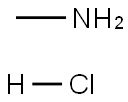What are the uses of Methylamine hydrochloride in different fields?
May 14,2024
Methylamine hydrochloride is an important solid organic compound, which can be used as raw material for organic synthesis, pharmaceutical intermediate, biologically active reagent and solar cell material, and has a wide range of applications in the fields of medicine, chemical industry and materials.

Pharmaceuticals
Methylamine hydrochloride is used as a synthetic raw material or pharmaceutical intermediate component in the manufacture of pharmaceuticals. It is used in the preparation of ephedrine, theophylline, herbicides, fungicides, insecticides, biocides and acaricides. In clinical studies, Methylamine hydrochloride is also used to treat eye diseases.
In addition, ammonium chloride (1-8 mM) and methylamine hydrochloride (1-16 mM) produce concentration-dependent antagonism of the onset of neuromuscular blockade caused by botulinum toxin types A, B and C (all at 1 X 10(-11) M) and by tetanus toxin (3 X 10(-10) M). Neither drug antagonizes the onset of paralysis caused by beta-bungarotoxin (1 X 10(-7) M) or by taipoxin (1 X 10(-8) M). At concentrations that produce antagonism of clostridial neurotoxins, ammonium chloride and methylamine hydrochloride (8-10 mM) do not inactivate toxin molecules, nor do they produce irreversible changes in tissue function. When studied under conditions that impose partial synchrony on the mechanism of clostridial neurotoxin action, ammonium chloride and methylamine hydrochloride do not inhibit ligand binding and do not reverse neuromuscular blockade. The drugs act solely to antagonize internalization of toxins by cholinergic nerve endings. As a result of inhibiting the process of internalization, the drugs trap the toxins at an antitoxin sensitive site.
Chemical field
Methylamine hydrochloride is used in the chemical industry to prepare methamphetamine and other methylamine hydrochloride derivatives.
Bis-(2-chloroethyl-1,2-3H) methylamine hydrochloride was prepared. The starting product was acetylene-1,2-3H which was selectively hydrogenated to ethylene-1,2-3H. It was observed that on reduction with chromium (II) chloride solution in dilute hydrochloric acid the isotopic exchange with acetylene-1,2-3H is negligible. Ethylene was converted to ethyleneoxide-1,2-3H by the usual method. Ethyleneoxide-1,2-3H can be used for synthesis of several labelled halogenalkylamines and as the starting compound for other syntheses.
Materials
Methylamine (MA) and methylamine hydrochloride (MACl) are widely used to prepare highly efficient and stable perovskite solar cells (PSCs). However, MA, as a gas, is difficult to handle and inevitably leads to a large amount of escape, and it is difficult to quantitatively calculate. With the introduction of 20 mol% MACl as additive, the fully printed MPSCs are fabricated without any posttreatment at room temperature via a one-step drop-coating method. As a consequence, the average power conversion efficiency (PCE) of 14.73 ± 0.3% (0.1 cm2) with almost no hysteresis is achieved. Most importantly, the device also exhibits excellent long-term stability when it is unencapsulated. Specifically, the unencapsulated device still retains nearly 100% of its original PCE after 64 days and 88% after 81 days of storage in the dark with a humidity of 50 ± 5% in an atmospheric environment. It provides a new idea for constructing fully printed MPSCs at room temperature in the future.
Bioactivity
Methylamine hydrochloride is a p-nitrophenyl phosphate substrate with an optimal concentration of 0.5 mg/ml in the reaction solution. The compound reacts with methylamine (produced by hydrolysis of peptide hormones in humans) to form a bicyclic heterocycle. The bicyclic heterocycle reacts with hydrogen fluoride in a model system to produce an analytical method for the determination of plasma mass spectrometry. Methylamine hydrochloride has been shown to inhibit biological activity at high concentrations and stimulate biological activity at low concentrations.
References:
[1] SIMPSON L L. Ammonium chloride and methylamine hydrochloride antagonize clostridial neurotoxins.[J]. Journal of Pharmacology and Experimental Therapeutics, 1983.
[2] FILIP J. Preparation of bis-/2-chloroethyl-1,2-3H/methylamine hydrochloride[J]. Journal of labelled compounds & radiopharmaceuticals, 1966. DOI:10.1002/jlcr.2590020308.
[3] JIAN LIU. Room-Temperature-Processed, Carbon-Based Fully Printed Mesoscopic Perovskite Solar Cells with 15% Efficiency[J]. Solar RRL, 2021. DOI:10.1002/solr.202100274.
- Related articles
- Related Qustion
- Methylamine Hydrochloride: A Comprehensive Overview for Chemical Professionals Dec 31, 2024
Methylamine hydrochloride is a compound of significant interest and utility in various chemical sectors.
- Methylamine hydrochloride: Application, Pharmacokinetics, Toxicity, storage, Preparation Apr 27, 2023
Methylamine hydrochloride is a salt of the organic compound methylamine and hydrochloric acid. It has the chemical formula CH3NH2·HCl and is a white to slightly yellow crystalline powder.
- Method for Recycling Methylamine Hydrochloride Oct 21, 2019
Methylamine is an organic compound with a formula of CH3NH2. This colorless gas is a derivative of ammonia, but with one hydrogen atom being replaced by a methyl group. It is the simplest primary amine.
1,7-Dimethylxanthine is a naturally occurring alkaloid compound that can enhance alertness and reduce drowsiness.....
Feb 27,2025APISLES is a common ingredient derived from petroleum and has been widely used in cosmetic products. It is intended to produce a lathering action to wash away oil and debris from your hair.....
Oct 22,2024SurfactantMethylamine hydrochloride
593-51-1You may like
Methylamine hydrochloride manufacturers
- Methylamine hydrochloride
-

- $0.00 / 1kg
- 2025-07-08
- CAS:593-51-1
- Min. Order: 1kg
- Purity: 99%
- Supply Ability: 10tons
- Methylamine hydrochloride
-

- $10.00 / 1ASSAYS
- 2025-07-08
- CAS:593-51-1
- Min. Order: 1ASSAYS
- Purity: 99%
- Supply Ability: 10 tons
- Methylamine HCL powder
-

- $10.00 / 1ASSAYS
- 2025-07-08
- CAS:593-51-1
- Min. Order: 1ASSAYS
- Purity: 99%
- Supply Ability: 10 tons






